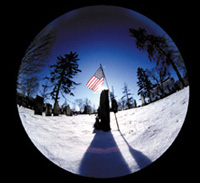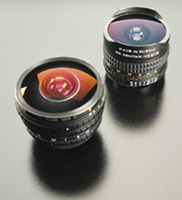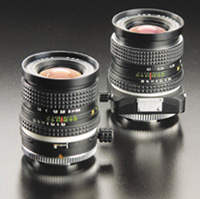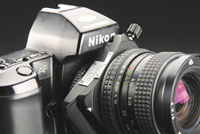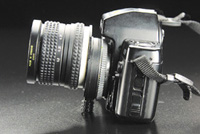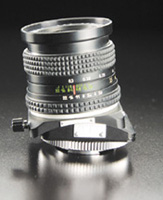The Wide And The Wierd
New Fisheye And PCS Lenses From Russia
After last year's exhaustive study of all things Russian, I thought I was done with Kiev equipment. While I had given up on most things Ukrainian as everyday shooters, I did still have a fine Kiev 60 body and a handful of Kiev lenses laying around. Since I make my living with medium format I really only looked at the Kiev rollfilm cameras and lenses--35mm gear never crossed my mind. One of our suppliers for the Kiev story, Michael Fourman of Kiev Camera USA (not to be mistaken for Saul Kaminsky's Kiev USA) got a hold of me earlier this year to inform me that he was carrying a whole bunch of rather spectacular 35mm lenses. As luck would have it these lenses were mostly Pentax screwmount or Nikon F mount, and I'm mostly a Canon EOS shooter. Well, I did have a couple of Nikon bodies kicking around the studio somewhere, didn't I? Wish List Why so excited? Because these are 35mm lenses that I didn't own. Sure I have a 17-35mm "L" series Canon lens, but at the widest setting it didn't have the extreme field curvature of a 16mm fisheye. Perspective control lenses were just as exciting. I do a lot of tabletop photography with a MegaVision T2 digital camera. The T2 has a Nikon lens mount. A perspective control lens with real lens tilt would be perfect for me, since I could tilt the lens to control depth of field--either get everything in focus or artificially throw most of the image out of focus. Since I would be working in the studio in a controlled situation, the lack of automatic aperture didn't bother me. Also, since I was shooting with studio flash, I could always stop down to f/16, ensuring decent performance. The box arrived, the peanuts spilled out and there they were, the finest optics the ex-Soviet Union lens factories were currently producing: the famed 8mm f/3.5 circular (almost) Peleng, the Russian 16mm f/2.8 Zenitar full frame fisheye, the Ukrainian sourced PCS Arsat 35mm f/2.8 shift lens, and the rare Arsat PCS 35mm f/2.8 tilt/shift lens. Wow, what a line-up! |
|||
Once you actually get these things in your hands, disappointment sets in. "Fit and finish" is not a phrase that comes up in many QC meetings in Russian plants these days. These lenses are sloppier, cruder, and wobblier than the normal lens on your Miranda DX-3, circa 1977. These are bargain lenses, no doubt, but do they work? Well, again, that's a loaded question. Many speak of the vaunted Russian optical quality, and, yes, I've been getting flat-out spectacular results from the 30mm fisheye on my Kiev 60. But the other Russian lenses have left me wanting more. To test them out I took all four lenses out on a bitter cold January day in New England and gave them some battle testing. I wasn't shy about it--I aimed the damn things straight into the winter sun and let the chips fall where they may. Like all things Russian, the results left me just as confused. Zenitar 16mm f/2.8--This is clearly the best and most usable lens in the bunch. For $200 or so you get a fairly normal looking little manual focus lens in standard Nikon Ai mount. This is a real lens with a well-damped rubber-coated focusing ring, a real automatic aperture, and what appears to be decent modern multi-coating. In my field test transparencies were really crisp and tack-sharp. Of course the corners suffer at anything less than f/11, but at f/16 this was one fine optic. The barrel distortion that a full frame fisheye produces is pretty addictive. Before you know it you're looking for long straight lines to curve. I found myself pushing up against skyscrapers and stone walls, just trying to introduce some fisheye distortion. |
|||
Although $200 isn't a lot for a lens these days, you can find the manual focus 17mm Tokina lens for under $300 in many places. Of course, to get into a real fisheye type lens you're looking at more money. This is a bargain anyway you slice it. I really like this lens and for little money you can create some very wild looks. Peleng 8mm f/3.5--Here's the really fun lens, the circular fisheye Peleng. Fourman sells these for under $200 and at that price it's just an irresistible bargain. The lens comes with a case, instructions in Russian, and three rear-mounted filters. How do you beat that? While sharpness is just fair and the lens tends to spill some light outside of the fisheye circle, it isn't bad and the effect is just mesmerizing. Since fisheye stuff, especially circular fisheye, is an effect that I use so sparingly, it kind of makes sense to own an affordable lens like this rather than rent a good lens for the one or two times a year you really need it. Since I've had this thing in my camera bag I've shot a ton of funky and fun images, almost all of them good enough to blow up into good-sized prints. "Circular" is a matter of interpretation. This lens doesn't paint a ball-shaped circle in the middle of the frame, since the top and bottom are slightly cropped. However, it does allow you to work with the mirror down, so you can compose and focus through the viewfinder--something that can't be said for all 8mm circulars. |
|||
Construction quality is really quite primitive. This is a T-mount lens that comes with a Pentax screw and Nikon F mount. To stop the lens down for shooting you use the "lock-unlock" ring, just like the stop-down ring on that Pentax Spotmatic F in the basement that your wife has been begging you to sell on eBay. It's a vintage approach, but it works. Since fisheye shooting isn't exactly a speedy process, it's not that big a price to pay. This is a basic and decidedly unmodern lens, but boy is it fun! Arsat PCS 35mm Shift and Tilt/Shift Lens--Here's where I was expecting great things. I use shift lenses several times a year, so the thought of owning an inexpensive shift lens that I could use on a Nikon body would be a great thing. The Arsat lens really doesn't strike you as a precision device. Unlike even the cheapest Sigma or Tokina lens, the lettering and numbering on the lens is poorly applied. Machining is often rough and the shift-adjusting knob wobbles slightly in its hole. The main body of the lens meets the base with a thick piece of poorly cut white nylon. It's a less than impressive package. The tilt/shift lens has the typical large block that incorporates the tilt and shift mechanisms. But that makes it nearly impossible to mount the lens on many Nikon bodies. While it may have worked fine on the Nikon Fs and Zenit 19s at the factory in Russia, it won't mount on a Nikon 8008, N90, or F5 due to the prism, which sticks out slightly on most modern Nikons. The only solution is to firmly grab the rotating base and begin turning it counterclockwise on the camera while rotating the lens clockwise. This allows you to slowly inch the lens mount onto the camera till it clicks, then set the lens where you want it. Of course you have to plan this out since the tilt and shift controls are on opposite sides of the lens and really were not intended to be used at the same time. In the field this was an average performing lens. Set flat with no movements, performance was decent, about what you'd expect from a modern zoom lens set at 35mm. When tilted the edges of the image begin to fuzz out quite badly at maximum tilt and wide-open. Shift was a little better, though the far edge of any shift image was still quite soft and displayed some chromatic aberrations. I've seen worse, but that was in the 1970s. In the studio with strobe lighting mounted to a high-end digital camera the results were actually quite good. At f/22 I was able to produce razor sharp images with a fantastic level of detail. The tilt mechanism worked perfectly, and I could throw any part of the scene into or out of focus at will. While you can't exactly get view-camera performance from a tilt/shift lens, it's the only way to get this level of control on a 35mm body. |
|||
Field test transparencies looked pretty good, except for the aforementioned softness at the edges. I used the tilt/shift in the studio to give me more depth of field on product shots and with people to blow everything in the image out of focus except for one specific area. In both instances the lens produced very good results. Of course, working with a T-mount manual lens is still a chore, and the weird set and release stop-down mechanism on these lenses leaves a lot to be desired. So there you have it: four wide and somewhat weird bargain lenses. The 16mm and the 8mm aren't exactly works of art, but the results you get are so cool that they're must-haves. The tilt/shift and shift lenses are well worth it if you occasionally have a call for this kind of thing. If you really need an excellent tilt/shift lens you'd be better served saving your money and buying a used Nikon or Canon lens. For my situation where it's handy to have, but not essential, $200 for the shift lens seems like exactly the right price. My bread and butter lenses are all Canon "L" series glass--17-35mm, 28-70mm, 70-200mm, with 1.4x and 2x converters. To have a few oddball wide lenses in the bag with an old Nikon body is a cost-effective way to always have these extreme effects at my fingertips. I guess I'm hooked again! For more information, contact Kiev Camera USA, 2907 Aspen Woods Entry, Atlanta, GA 30360; phone/fax: (770) 409-0026; www.kievcamera.com Photos continued below. |
|||
|

